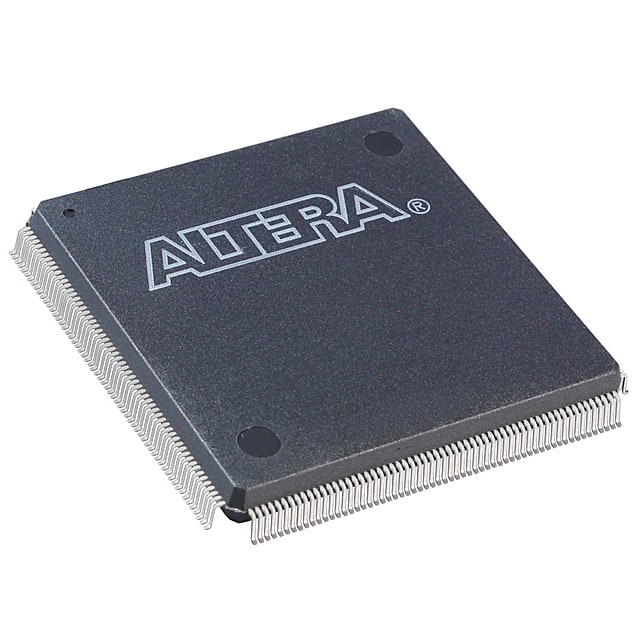Xem thông số kỹ thuật để biết chi tiết sản phẩm.

EPF10K30AQC240-2N
Product Overview
Category: Programmable Logic Device (PLD)
Use: The EPF10K30AQC240-2N is a PLD designed for digital circuitry applications. It offers programmable logic functions and flexible configuration options, making it suitable for various electronic systems.
Characteristics: - High-performance programmable logic device - Versatile and adaptable to different circuit designs - Efficient power consumption - Reliable and durable
Package: The EPF10K30AQC240-2N comes in a compact quad flat pack (QFP) package, which provides ease of installation and integration into electronic circuits.
Essence: This PLD is built to provide efficient and customizable logic functions, enabling designers to implement complex digital circuitry with ease.
Packaging/Quantity: The EPF10K30AQC240-2N is typically packaged individually and is available in various quantities depending on the supplier.
Specifications
- Logic Elements: 30,000
- Maximum Operating Frequency: 200 MHz
- Number of I/O Pins: 240
- Supply Voltage: 3.3V
- Package Type: QFP
- Operating Temperature Range: -40°C to +85°C
Pin Configuration
The EPF10K30AQC240-2N has a total of 240 pins, each serving a specific purpose in the circuit design. The detailed pin configuration can be found in the product datasheet provided by the manufacturer.
Functional Features
- Flexible Logic Functions: The EPF10K30AQC240-2N offers a wide range of programmable logic functions, allowing designers to create custom digital circuits tailored to their specific requirements.
- Fast Operation: With a maximum operating frequency of 200 MHz, this PLD ensures high-speed data processing and efficient performance.
- Easy Configuration: The device can be easily programmed using industry-standard hardware description languages (HDL) or design software, enabling quick and hassle-free implementation.
Advantages and Disadvantages
Advantages: - Versatile and adaptable to different circuit designs - High-performance and fast operation - Efficient power consumption - Easy to program and configure
Disadvantages: - Limited logic elements compared to higher-end PLDs - May require additional support components for complex designs
Working Principles
The EPF10K30AQC240-2N operates based on the principles of programmable logic. It consists of configurable logic blocks (CLBs), interconnect resources, and input/output blocks (IOBs). The CLBs contain look-up tables (LUTs) that can be programmed to implement various logic functions. The interconnect resources allow for flexible routing of signals between different CLBs and IOBs. The IOBs provide interfaces for external connections.
During operation, the PLD is programmed to define the desired logic functions and interconnections. The programmed configuration is stored in non-volatile memory within the device. When powered on, the PLD executes the programmed logic, processing input signals and generating output signals according to the defined circuitry.
Detailed Application Field Plans
The EPF10K30AQC240-2N finds applications in various fields, including: 1. Telecommunications: Used in network routers, switches, and communication equipment for signal processing and data routing. 2. Industrial Automation: Employed in control systems, robotics, and manufacturing equipment for implementing custom logic functions. 3. Automotive Electronics: Integrated into automotive control units for managing vehicle subsystems and performing real-time operations. 4. Consumer Electronics: Utilized in digital TVs, set-top boxes, and gaming consoles for signal processing and user interface control.
Alternative Models
For those seeking alternative options, the following PLDs can be considered: 1. EPF10K50SQC240-3: Offers higher logic capacity and additional features for more complex designs. 2. EPF10K100ABC356-1: Provides a larger number of I/O pins and enhanced performance capabilities. 3. EPF10K200SFC484-2: Suitable for applications requiring extensive logic resources and high-speed operation.
These alternative models offer varying specifications and capabilities to cater to different design requirements.
Word count: 514 words
Liệt kê 10 câu hỏi và câu trả lời thường gặp liên quan đến ứng dụng EPF10K30AQC240-2N trong giải pháp kỹ thuật
Sure! Here are 10 common questions and answers related to the application of EPF10K30AQC240-2N in technical solutions:
Question: What is EPF10K30AQC240-2N?
- Answer: EPF10K30AQC240-2N is a programmable logic device (PLD) manufactured by Intel. It is commonly used in various technical solutions for digital circuit design.Question: What are the key features of EPF10K30AQC240-2N?
- Answer: Some key features of EPF10K30AQC240-2N include 30,000 usable gates, 240-pin quad flat pack (QFP) package, 2.5V core voltage, and 3.3V I/O voltage.Question: What are the typical applications of EPF10K30AQC240-2N?
- Answer: EPF10K30AQC240-2N is commonly used in applications such as industrial control systems, telecommunications equipment, medical devices, automotive electronics, and consumer electronics.Question: How can EPF10K30AQC240-2N be programmed?
- Answer: EPF10K30AQC240-2N can be programmed using the Quartus II software provided by Intel. The programming file can be loaded onto the PLD using a programmer or through JTAG interface.Question: Can EPF10K30AQC240-2N be reprogrammed?
- Answer: Yes, EPF10K30AQC240-2N is a reprogrammable device. It can be erased and reprogrammed multiple times, allowing for flexibility in design iterations.Question: What is the maximum operating frequency of EPF10K30AQC240-2N?
- Answer: The maximum operating frequency of EPF10K30AQC240-2N depends on the complexity of the design and other factors. It can typically operate at frequencies up to several tens of megahertz.Question: Can EPF10K30AQC240-2N interface with other digital components?
- Answer: Yes, EPF10K30AQC240-2N can interface with other digital components such as microcontrollers, memory devices, sensors, and communication interfaces through its I/O pins.Question: What are the power requirements for EPF10K30AQC240-2N?
- Answer: EPF10K30AQC240-2N requires a 2.5V core voltage and a 3.3V I/O voltage for proper operation. Adequate power supply and decoupling capacitors should be used to ensure stable operation.Question: Are there any limitations or considerations when using EPF10K30AQC240-2N?
- Answer: Some considerations include understanding the device's timing constraints, ensuring proper power supply and decoupling, and designing for thermal management due to power dissipation.Question: Where can I find more information about EPF10K30AQC240-2N?
- Answer: You can refer to the datasheet, application notes, and technical documentation provided by Intel for detailed information about EPF10K30AQC240-2N. Additionally, online forums and communities may also provide valuable insights and support.

